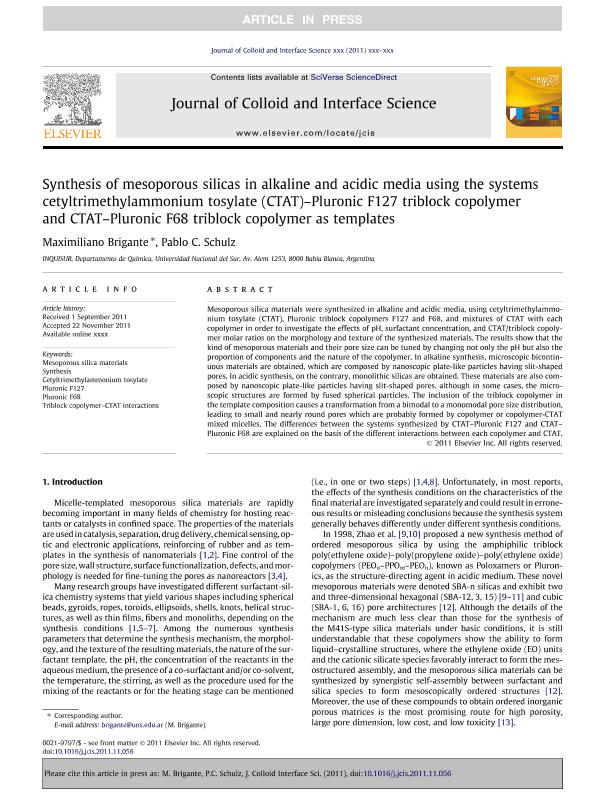Mostrar el registro sencillo del ítem
dc.contributor.author
Brigante, Maximiliano Eduardo

dc.contributor.author
Schulz, Pablo Carlos

dc.date.available
2018-11-08T18:37:22Z
dc.date.issued
2012-03
dc.identifier.citation
Brigante, Maximiliano Eduardo; Schulz, Pablo Carlos; Synthesis of mesoporous silicas in alkaline and acidic media using the systems cetyltrimethylammonium tosylate (CTAT)-Pluronic F127 triblock copolymer and CTAT-Pluronic F68 triblock copolymer as templates; Academic Press Inc Elsevier Science; Journal of Colloid and Interface Science; 369; 1; 3-2012; 71-81
dc.identifier.issn
0021-9797
dc.identifier.uri
http://hdl.handle.net/11336/64009
dc.description.abstract
Mesoporous silica materials were synthesized in alkaline and acidic media, using cetyltrimethylammonium tosylate (CTAT), Pluronic triblock copolymers F127 and F68, and mixtures of CTAT with each copolymer in order to investigate the effects of pH, surfactant concentration, and CTAT/triblock copolymer molar ratios on the morphology and texture of the synthesized materials. The results show that the kind of mesoporous materials and their pore size can be tuned by changing not only the pH but also the proportion of components and the nature of the copolymer. In alkaline synthesis, microscopic bicontinuous materials are obtained, which are composed by nanoscopic plate-like particles having slit-shaped pores. In acidic synthesis, on the contrary, monolithic silicas are obtained. These materials are also composed by nanoscopic plate-like particles having slit-shaped pores, although in some cases, the microscopic structures are formed by fused spherical particles. The inclusion of the triblock copolymer in the template composition causes a transformation from a bimodal to a monomodal pore size distribution, leading to small and nearly round pores which are probably formed by copolymer or copolymer-CTAT mixed micelles. The differences between the systems synthesized by CTAT-Pluronic F127 and CTAT-Pluronic F68 are explained on the basis of the different interactions between each copolymer and CTAT. © 2011 Elsevier Inc.
dc.format
application/pdf
dc.language.iso
eng
dc.publisher
Academic Press Inc Elsevier Science

dc.rights
info:eu-repo/semantics/openAccess
dc.rights.uri
https://creativecommons.org/licenses/by-nc-sa/2.5/ar/
dc.subject
Cetyltrimethylammonium Tosylate
dc.subject
Mesoporous Silica Materials
dc.subject
Pluronic F127
dc.subject
Pluronic F68
dc.subject
Synthesis
dc.subject
Triblock Copolymer-Ctat Interactions
dc.subject.classification
Otras Ciencias Químicas

dc.subject.classification
Ciencias Químicas

dc.subject.classification
CIENCIAS NATURALES Y EXACTAS

dc.title
Synthesis of mesoporous silicas in alkaline and acidic media using the systems cetyltrimethylammonium tosylate (CTAT)-Pluronic F127 triblock copolymer and CTAT-Pluronic F68 triblock copolymer as templates
dc.type
info:eu-repo/semantics/article
dc.type
info:ar-repo/semantics/artículo
dc.type
info:eu-repo/semantics/publishedVersion
dc.date.updated
2018-11-05T19:05:23Z
dc.journal.volume
369
dc.journal.number
1
dc.journal.pagination
71-81
dc.journal.pais
Estados Unidos

dc.journal.ciudad
Nueva York
dc.description.fil
Fil: Brigante, Maximiliano Eduardo. Consejo Nacional de Investigaciones Científicas y Técnicas. Centro Científico Tecnológico Conicet - Bahía Blanca. Instituto de Química del Sur. Universidad Nacional del Sur. Departamento de Química. Instituto de Química del Sur; Argentina
dc.description.fil
Fil: Schulz, Pablo Carlos. Consejo Nacional de Investigaciones Científicas y Técnicas. Centro Científico Tecnológico Conicet - Bahía Blanca. Instituto de Química del Sur. Universidad Nacional del Sur. Departamento de Química. Instituto de Química del Sur; Argentina
dc.journal.title
Journal of Colloid and Interface Science

dc.relation.alternativeid
info:eu-repo/semantics/altIdentifier/url/https://www.sciencedirect.com/science/article/pii/S0021979711014329
dc.relation.alternativeid
info:eu-repo/semantics/altIdentifier/doi/https://dx.doi.org/10.1016/j.jcis.2011.11.056
Archivos asociados
